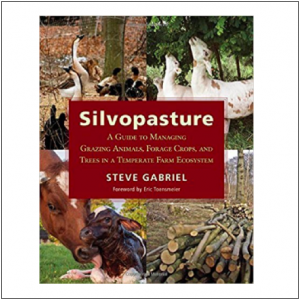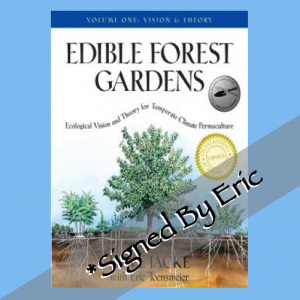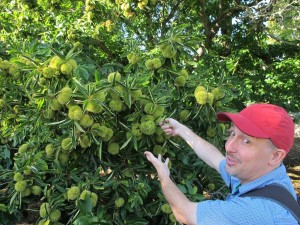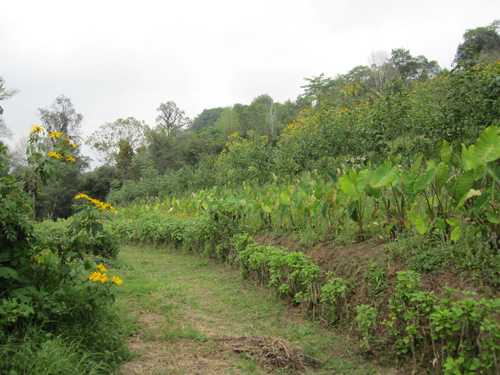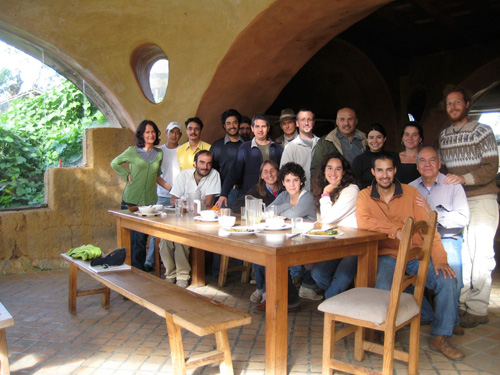Recent decades have seen excellent work in prioritizing gardening with native species. However, most all–native gardens are not sufficiently ecological in that they do not provide the food and other needs of human inhabitants, nor accept and cycle their wastes. The ecological garden must embrace a wider perspective that de–externalizes the ecological footprint of the modern lifestyle, from the global food system to the fossil fuels that prop up our way of life.
There’s been lots of conflict between the native plants and permaculture wings of the environmental movement over the use of non-native useful plants. I’m sure we will continue to argue over particular species like hardy kiwifruit for decades to come. What we rarely focus on, though, is the great amount of common ground we actually share: useful native plants.
Northeastern Indians wild–managed, cultivated, and domesticated native plants in this region for millennia. Many native people still do, like the wild rice harvesters of the lakes region. We have an excellent palette of useful native species to work with. In my writing and teaching in the last few years I’ve been promoting this idea and finding that few people on either end of the conversation have truly explored the potential of our native flora. Few eastern native plants are available in our supermarkets: wild rice, grape jelly, sunflower seeds, pecans, blueberries and cranberries are among the exceptions. We need to learn, grow, and domesticate useful native species to serve as an anchor of a truly ecological society. And we will surely continue to need to use some species from outside the region to fill the gaps and provide a more diverse and productive landscape.
I propose an alliance between our branches of the ecological movement, promoting the great number of species that represent the overlap of our areas of concern. We both agree that non-useful, ornamental species from outside the region should be at the bottom of anyone’s species selection criteria. A platform for this new agenda might choose the blueberry as its emblem–a native edible crop that is an outstanding ornamental in all four seasons and an important anchor for the food chain through its hosting of numerous moth and caterpillar larvae.
For some forward-thinking projects, this discussion is about to become very grounded in reality. New buildings certified by the Living Building Challenge (a revolutionary new green building certificate that leaves LEED in the dust) are required to produce food on at least a third of the landscape in recognition of this ecological necessity. Will sites choose the hard–line but deeply interesting and educational option of growing only native food plants? Native to the Northeast, their state, or even their county? Or might they choose to also incorporate some familiar and better-producing fruits and vegetables in the mix, including known naturalizers like carrots and apples? I look forward to a lively discussion.
I’ve posted a list of over 200 useful perennial Useful Native Species of the Eastern Forest (including sixty native to Hampshire County) here. You can also find in my blog archive an article called “All Nitrogen Fixers Are Not Created Equal”, which reviews the pounds of nitrogen per acre fixed by native and non-native species of the eastern forest region, offering objective criteria for selecting superior native nitrogen fixers. I’ve also posted a table of eastern native plants that were wild-managed, cultivated, or domesticated by native people in the pre-colonial era below. Please use these tools to explore the uses and assess the current state of domestication of our native flora. You may also enjoy my article and video about growing out and eating ancient native annual crops. I think they show the potential and current limitations of the subject.
INDIGENOUS MANAGEMENT and CULTIVATION of
EASTERN FOREST PLANT SPECIES
Sources: Foraging and Farming in the Eastern Woodlands (ed. C. Margaret Scarry), Food Plants of the North American Indians (V. Harvard), Some Ecological Aspects of Northeastern Indian Agroforestry Practices (Karl Davies), Forgotten Fires (Omer Stewart), Cultivated landscapes of North America (William Doolittle), Giant Cane: Arundinaria gigantea (USDA NRCS).
| LATIN NAME | COMMON NAME | WILD-MANAGED | CULTIVATED | DOMESTICATED |
| TREES | ||||
| Carya spp. | Hickories & pecans | Burning | Yes | |
| Castanea dentata | American chestnut | Burning before harvest | ||
| Juglans spp. | Butternut & black walnut | Burning | ||
| Morus rubra | Red mulberry | Yes | ||
| Quercus spp. | Oaks | burning |
| LATIN NAME | COMMON NAME | WILD-MANAGED | CULTIVATED | DOMESTICATED |
| SHRUBS | ||||
| Arundinaria giganteaa | Canebrake bamboo | Burning | Yes | |
| Corylus spp. | Native hazels | Burning, pruning | ||
| Ilex vomitoria | Yaupon holly | Yes | ||
| Prunus Americana | American plum | Yes | ||
| Vaccinium angustifolium | Lowbush blueberry | Burning | Yes |
| LATIN NAME | COMMON NAME | WILD-MANAGED | CULTIVATED | DOMESTICATED |
| VINES | ||||
| Amphicarpa bracteata | Hog peanut | Semicultivated | ||
| Apios americana | Groundnut | Yes | Partially | |
| Passiflora incarnata | Maypop passionfruit | Semicultivated | ||
| Phaseolus polystachios | Thicket bean | Semicultivated | ||
| Vitis spp. | Grapes | Yes |
| LATIN NAME | COMMON NAME | WILD-MANAGED | CULTIVATED | DOMESTICATED |
| PERENNIALS | ||||
| Helianthus tuberosa | Sunchoke | Semicultivated | Yes | |
| Physalis spp. | Perennial ground cherries | Semicultivated | ||
| Phytolacca americana | Pokeweed | Yes |
| LATIN NAME | COMMON NAME | WILD-MANAGED | CULTIVATED | DOMESTICATED |
| ANNUALS | ||||
| Amaranthus spp. | Amaranth | Semicultivated | ||
| Ambrosia trifida | Giant ragweed | Semicultivated | ||
| Chenopodium berlandieri | Chenopod | Cultivated | Yes | |
| Cucurbita pepo ovifera | Acorn and zucchini squash | Cultivated | Yes | |
| Euphorbia maculata | Spurge | Semicultivated | ||
| Helianthus annuus | Sunflower | Cultivated | Yes | |
| Iva annua | Sumpweed | Cultivated | Yes | |
| Mollugo verticillata | Carpetweed | Semicultivated | ||
| Phalaris caroliniana | Maygrass | Semicultivated | Yes | |
| Physalis spp. | Annual ground cherries | Semi-cultivated | ||
| Polygonum erectum | Knotweed | Cultivated | Yes | |
| Portulaca spp. | Native purslanes | Semicultivated | ||
| Rumex spp. | Native docks | Semicultivated | ||
| Solanum spp. | Black nightshade | Semicultivated | ||
| Stellaria spp. | Native chickweeds | Semicultivated | ||
| Strophostyles helvola | Woolly bean | Semicultivated |
| LATIN NAME | COMMON NAME | WILD-MANAGED | CULTIVATED | DOMESTICATED |
| AQUATICS | ||||
| Nelumbo lutea | Native lotus | Semicultivated | ||
| Orontium aquaticum | Golden club | Semicultivated | ||
| Peltandra virginica | Tuckahoe | Semicultivated | ||
| Zizania aquatica | Wild rice | Intensive wild management |

